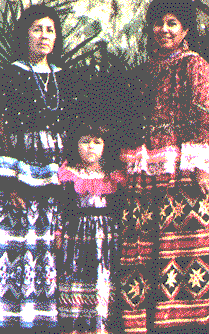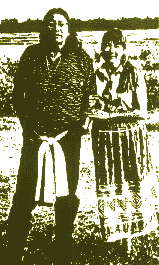Related stories: Seminole History Seminole Attractions Ah-Tha-Ti-Ki Museum Billy's Swamp Safari Publisher's Note


 Photo courtesy of the Seminole Tribe of Florida Chairman of the Seminole Tribe of Florida, James E. Billie, wearing a patchwork sweater. |
Sometimes women sewed patterns that were symbolic of Seminole clans. Each Seminole Indian born from a Seminole mother is a member of her clan, a traditional extended family unit: bear, snake, panther, toad/bigtown, bird, deer, wind, otter. Some designs reflected daily life: lightning striking across the sky, crosses that reflected Christian teachings, fires that raced through the swamp, the spools that held the colored threads used to sew the very patchwork. A design might be named after its creator. Copying a designer was a high compliment. Color might play a part, and sometimes reflected the medicine colors of the four directions.
 Photo courtesy of the Seminole Tribe of Florida Below left, Seminole ladies in patchwork regalia. |
From the 1970's to the present, many seamstresses enlarged their designs and began utilizing fabrics other than cotton for special occasions. Although a few traditional people still wear patchwork for every day, most now wear their patchwork for ceremonial or special occasions. Patchwork vests are worn frequently today. Patchwork has also been used to decorate all other types of clothing.
Seminole and Miccosukee women have been creating patchwork for nearly a century. Passed on through generations, this unique art is a source of cultural pride, a testament to the adaptability, and creativity of a people whose artistic achievement continues to flourish.
 Resources:
Resources:
Ah Tha Thi Ki Museum
Patchwork and Palmettos, Seminole-Miccosukee Folk Art since 1820, by David Blackard, from an exhibition sponsored by the Ft. Lauderdale Historical Society, 1990
Don Many Bad
Horses and writer Victoria Westermark Many Bad Horses, wearing her Seminole
patchwork skirt from the 1950s.